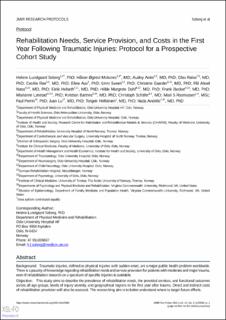| dc.contributor.author | Søberg, Helene Lundgaard | |
| dc.contributor.author | Moksnes, Håkon Øgreid | |
| dc.contributor.author | Anke, Audny | |
| dc.contributor.author | Røise, Olav | |
| dc.contributor.author | Røe, Ellen-Cecilie Treu | |
| dc.contributor.author | Aas, Eline | |
| dc.contributor.author | Sveen, Unni | |
| dc.contributor.author | Gaarder, Christine | |
| dc.contributor.author | Næss, Pål Aksel | |
| dc.contributor.author | Helseth, Eirik | |
| dc.contributor.author | Dahl, Hilde Margrete | |
| dc.contributor.author | Becker, Frank | |
| dc.contributor.author | Løvstad, Marianne | |
| dc.contributor.author | Bartnes, Kristian | |
| dc.contributor.author | Schäfer, Christoph | |
| dc.contributor.author | Rasmussen, Mari Storli | |
| dc.contributor.author | Perrin, Paul B. | |
| dc.contributor.author | Lu, Juan | |
| dc.contributor.author | Hellstrøm, Torgeir | |
| dc.contributor.author | Hadzic-Andelic, Nada | |
| dc.coverage.spatial | Norway | en_US |
| dc.date.accessioned | 2021-09-24T11:26:19Z | |
| dc.date.available | 2021-09-24T11:26:19Z | |
| dc.date.created | 2021-04-21T12:01:06Z | |
| dc.date.issued | 2021-04-14 | |
| dc.identifier.issn | 1929-0748 | |
| dc.identifier.uri | https://hdl.handle.net/11250/2781409 | |
| dc.description.abstract | Background: Traumatic injuries, defined as physical injuries with sudden onset, are a major public health problem worldwide. There is a paucity of knowledge regarding rehabilitation needs and service provision for patients with moderate and major trauma, even if rehabilitation research on a spectrum of specific injuries is available. Objective: This study aims to describe the prevalence of rehabilitation needs, the provided services, and functional outcomes across all age groups, levels of injury severity, and geographical regions in the first year after trauma. Direct and indirect costs of rehabilitation provision will also be assessed. The overarching aim is to better understand where to target future efforts. Methods: This is a population-based prospective follow-up study. It encompasses patients of all ages with moderate and severe acute traumatic injury (New Injury Severity Score >9) admitted to the regional trauma centers in southeastern and northern Norway over a 1-year period (2020). Sociodemographic and injury data will be collected. Upon hospital discharge, rehabilitation physicians estimate rehabilitation needs. Rehabilitation needs are assessed by the Rehabilitation Complexity Scale Extended–Trauma (RCS E–Trauma; specialized inpatient rehabilitation), Needs and Provision Complexity Scale (NPCS; community-based rehabilitation and health care service delivery), and Family Needs Questionnaire–Pediatric Version (FNQ-P). Patients, family caregivers, or both will complete questionnaires at 6- and 12-month follow-ups, which are supplemented by telephone interviews. Data on functioning and disability, mental health, health-related quality of life measured by the EuroQol Questionnaire (EQ-5D), and needs and provision of rehabilitation and health care services are collected by validated outcome measures. Unmet needs are represented by the discrepancies between the estimates of the RCS E–Trauma and NPCS at the time of a patient’s discharge and the rehabilitation services the patient has actually received. Formal service provision (including admission to inpatient- or outpatient-based rehabilitation), informal care, and associated costs will be collected. Results: The project was funded in December 2018 and approved by the Regional Committee for Medical and Health Research Ethics in October 2019. Inclusion of patients began at Oslo University Hospital on January 1, 2020, and at the University Hospital of North Norway on February 1, 2020. As of February 2021, we have enrolled 612 patients, and for 286 patients the 6-month follow-up has been completed. Papers will be drafted for publication throughout 2021 and 2022. Conclusions: This study will improve our understanding of existing service provision, the gaps between needs and services, and the associated costs for treating patients with moderate and major trauma. This may guide the improvement of rehabilitation and health care resource planning and allocation. | en_US |
| dc.description.sponsorship | Financial support was provided by the Southeastern Norway Regional Health Authority and contributions from the Personal Injury Association, Personskadeforbundet, LTN. | en_US |
| dc.language.iso | eng | en_US |
| dc.publisher | JMIR Publications | en_US |
| dc.relation.ispartofseries | JMIR Research Protocols;Vol. 10 | iss. 4 | e25980 | |
| dc.rights | Navngivelse 4.0 Internasjonal | * |
| dc.rights.uri | http://creativecommons.org/licenses/by/4.0/deed.no | * |
| dc.subject | Traumas | en_US |
| dc.subject | Rehabilitation needs | en_US |
| dc.subject | Health services | en_US |
| dc.subject | Costs | en_US |
| dc.subject | Rehabilitation | en_US |
| dc.subject | Traumatic injuries | en_US |
| dc.subject | Injuries | en_US |
| dc.title | Rehabilitation Needs, Service Provision, and Costs in the First Year Following Traumatic Injuries: Protocol for a Prospective Cohort Study | en_US |
| dc.type | Peer reviewed | en_US |
| dc.type | Journal article | en_US |
| dc.description.version | publishedVersion | en_US |
| dc.rights.holder | © Helene Lundgaard Soberg, Håkon Øgreid Moksnes, Audny Anke, Olav Røise, Cecilie Røe, Eline Aas, Unni Sveen, Christine Gaarder, Pål Aksel Næss, Eirik Helseth, Hilde Margrete Dahl, Frank Becker, Marianne Løvstad, Kristian Bartnes, Christoph Schäfer, Mari S Rasmussen, Paul Perrin, Juan Lu, Torgeir Hellstrøm, Nada Andelic. | en_US |
| dc.source.articlenumber | e25980 | en_US |
| cristin.ispublished | true | |
| cristin.fulltext | original | |
| cristin.qualitycode | 1 | |
| dc.identifier.doi | https://doi.org/10.2196/25980 | |
| dc.identifier.cristin | 1905553 | |
| dc.source.journal | JMIR Research Protocols | en_US |
| dc.source.volume | 10 | en_US |
| dc.source.issue | 4 | en_US |
| dc.source.pagenumber | 1-10 | en_US |

